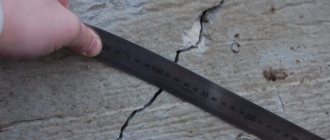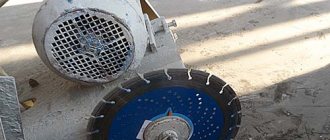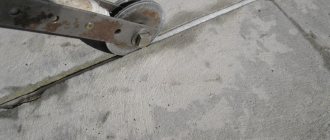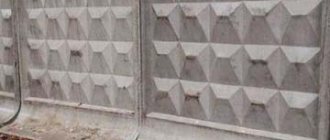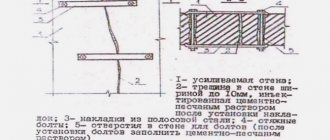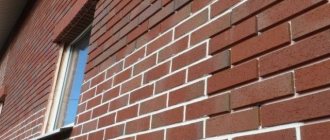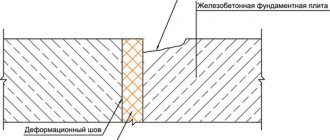Concrete is a material that is distinguished by its strength, but natural influences can harm even such a reliable foundation. Over time, moisture and other precipitation can begin to destroy the concrete structure and cracks may form, which must be repaired to extend the life of the building. For this purpose, it is convenient to use a concrete sealant. The specifics of using the composition, its types and selection rules will be discussed in detail below.
Purpose of expansion joints
A concrete base can withstand many loads and is resistant to tension and compression, but changes in temperature, defrosting and freezing of the surface lead to the creation of cracks on the surface. To prevent this, expansion joints are created. This is a special effect on certain areas to reduce external and internal influences on the geometry of concrete slabs. Expansion joints have three types:
- Structural ones are required to divide the base into zones, laying work with which takes place at different times, which helps reduce the formation of cracks;
- Shrinkage, when the hardening process is completed, shrinkage of concrete begins; if grooves are made, they will reduce the level of shrinkage effects and increase resistance to loads;
- Insulating ones are used when it is necessary to zone cement screeds with other bases.
Sealant for expansion joints in concrete floors creates high-quality protection in expansion joint areas, which prevents dirt from penetrating under the top layer of concrete. Sealing the space allows you to strengthen the screed, increases resistance to abrasion, and the appearance of chips at the joints. These are important reasons for using concrete joint sealant.
Sealant for expansion joints in concrete floors creates high-quality protection in expansion joint areas, which prevents dirt from penetrating under the top layer of concrete.
What materials and tools are needed to seal concrete floor joints?
The sealant is supplied conveniently packaged in tubes, and is applied using a manual or pneumatic construction gun, or a spatula.
Before applying the sealant, the surfaces must be cleaned of dirt, remnants of old sealant, and in winter - from snow and ice. If necessary, they are degreased with acetone and primed.
Do seams need to be sealed?
Seams are divided into movable and fixed. The first type is created during the construction process, laid down immediately by the designers to allow the building to “move”, that is, they withstand natural shrinkage processes during operation. The second type is used to fill voids in the joint areas between two elements. Over time, you may encounter destruction of the layer of sealant for joints in concrete, the cause may be:
- Technological standards were violated during the construction of the structure;
- Surface deformation from exposure to temperature and precipitation;
- Use of poor quality materials;
- Natural influence of time.
As a result, moisture can penetrate inside, heat will escape, mold and mildew may form, and the material may collapse. Therefore, from time to time it is worth checking the quality of the seams in order to update the protection at the right time.
From time to time it is worth checking the quality of the seams in order to update the protection at the right time.
Sealing mastic for concrete joints
In construction, different types of sealants are used, which differ from each other:
- number of components – one- and two-component;
- chemical nature.
- acrylic;
- polyurethane - have the best performance in terms of resistance, relative elongation, strength and durability;
- made of latex.
Germotex - mastic for joints in concrete
Work technology
Below are instructions that describe in detail the process of sealing expansion joints of a concrete floor with a two-component sealant:
- Prepare tools and materials:
- sealant mastic;
- primer for deep penetration concrete - strengthen the substrate;
- brush - apply primer;
- narrow triangular spatula - level the layer of sealant;
- frame gun - squeeze the sealing compound into the gap.
- Prepare the foundation, which after these works should be:
- strong;
- dry;
- have no signs of fungal infection;
- dust free;
- cleaned of bulk materials, dirt, oil, grease, rust, old paint and other substances, as well as loose particles that can affect the quality of adhesion between materials.
Regulatory requirements for expansion joints in concrete floors
There are regulatory requirements that apply to expansion joints; they are specified in SNiP 2.03.03-88:
- The creation of such seams is mandatory for buildings where temperature changes may occur from plus to minus. Sealing of joints should be done with polymer materials with plastic properties, the width depends on the maximum linear vibrations of the concrete coating, which were obtained in the calculations;
- You can create seams while pouring the concrete material, or make slats after the surface has dried;
- Seams are made at a distance of 8-12 meters when the flooring is solid on a reinforced concrete base. In other situations, the calculation is done individually, taking into account the loads, the thickness of the coating, and the features of the base. The seam lines are made perpendicular to each other;
- Expansion joints are made on the 1st line with similar parts in the structure. When slopes are created to drain water, they are created along the watershed line.
The location of these joints must be specified in the project; the concrete between the pouring zones should not touch. Cold joint types have the ability to expand in width, for this reason cement sealant can be used 5-6 months after grouting. Other types can be repaired immediately.
The creation of such seams is mandatory for buildings where temperature changes may occur from plus to minus.
Why is this necessary?
One of the main enemies of concrete is water, which, due to its fluidity, can penetrate into the most microscopic pores of the material. After some time, it begins to destroy the base, ultimately rendering it completely unusable.
Bitumen-based mastic
This material makes it possible to carry out waterproofing work with your own hands, even if you do not have sufficient qualifications.
- be single or multi-layered;
- have a thickness from 1 mm to several centimeters;
- form a film that reliably protects the material from water and deformation;
- resist acids and alkalis.
However, only a waterproofing polymer additive will increase the service life of this protection to several decades. She will be able to cope well with the expected loads.
In the photo - protecting a concrete foundation from moisture
Such additives allow hot, inexpensive bitumen mastics for foundation waterproofing to acquire greater elasticity and penetrating ability. In this case, you must have a heating tool, and you must follow fire safety precautions.
Application
Waterproofing mastic in our case will be used for:
- sealing cracks that appeared due to sudden temperature changes.
- creating a hydrophobic film for foundations.
- restoration work , when individual sections of the concrete base peeled off and its structure was exposed, i.e. coarse aggregate was exposed.
- waterproofing concrete screeds and seams.
In its characteristics and production method, mastic resembles glue. It differs from it in better viscosity and the presence of additional components. There are many varieties of it, usually they are divided for use outside the building, which have well-defined weather resistance, or inside.
In composition they can be:
- bitumen;
- polymer;
- bitumen-polymer;
- rubber bitumen.
One-component mastic for concrete
In addition to the main components, the composition often includes additives, including solvents and fillers. They make it possible to use them as an adhesive composition, for example, in the manufacture of adhesive waterproofing of concrete foundations. Based on their composition, they are distinguished into:
| One-component | They are made using solvents and, after being applied to the surface, begin to harden when exposed to air. As a result, they turn into a solid homogeneous mass. |
| Two-component | The material does not contain solvents and for the most part are low-active chemical compounds, which increases their shelf life. |
Advice: if you are unable to make a communication channel in the foundation using conventional methods, diamond drilling of holes in concrete will help you.
You must understand that there are mastics intended only for creating waterproofing, and there are those that are also used for gluing other materials to the base. Among the large list of the latter, bitumen is widely used, the price of which is quite reasonable.
There is also a separate version of mastic, which is called road mastic. It is intended for waterproofing and sealing seams and cracks of asphalt concrete and cement road surfaces.
Polyurethane two-component mastic
Thanks to the possibility of combining different starting materials:
- rubber;
- synthetic resins;
- plasticizers;
- fillers,
obtain materials with increased strength and elasticity. In addition, they are resistant to aging and aggressive environments, high and low temperatures.
Mastics are divided depending on the characteristics of the binding components, they can be:
- elastic;
- plastic;
- not drying out;
- drying out.
The most widespread are:
- bitumen;
- polymer;
- polymer-bitumen, combining the properties of the two previous types.
Areas of application
According to the scope of use, concrete sealant is used for connecting areas of load-bearing and enclosing structures, for openings of windows and doors. Along horizontal seams, in parts where there is a negative impact of water, salts, freezing, thawing, the process of increasing humidity and drying is underway for underground structures.
According to the scope of use, concrete sealant is used for connecting areas of load-bearing and enclosing structures, for openings of windows and doors.
Functional properties
Sealant for joints in concrete for external or internal use, for different areas of processing, manufacturers produce different compositions that are suitable for different tasks. For this reason, you need to understand the functional properties in order to choose the appropriate impregnation option.
You need to understand the functional properties in order to choose the appropriate impregnation option.
Strengthening
They are created on an inorganic basis and are released by penetrating the cement structure, which allows a chemical reaction to begin. The result is the production of substances that are not dissolved by exposure to water; this strengthens the properties of the concrete itself.
There are polymer sealants that penetrate the concrete lattice, strengthening the texture, but most often organic impregnations serve to create a protective layer on the surface.
They are created on an inorganic basis and are released by penetrating the cement structure, which allows a chemical reaction to begin.
Water repellent
The waterproof property allows you to extend the service life of the concrete surface. Concrete is durable, but water can destroy even such a layer. Impregnations create a layer that does not allow moisture to pass to the base. As a result, mold and mildew do not form, frost-resistant properties are acquired, and efflorescence does not appear.
But impregnating materials do not serve as protection against groundwater, so it is necessary to create a separate waterproof layer from the bottom.
The waterproof property allows you to extend the service life of the concrete surface.
Dust removal
Inside the house, dust removal helps reduce pollution, which has a positive effect on the health of the people living in the house. However, the appearance of dust from the concrete base serves as a signal of surface abrasion, which leads to destruction of the base. For this reason, dust-removing impregnations are also used for outdoor work.
Inside the house, dust removal helps reduce pollution, which has a positive effect on the health of the people living in the house.
Coloring
Conventional painting will not last long; concrete floors are subject to various loads, which does not allow paint and varnish products to retain color for a long time. It is better to choose special colored impregnations for concrete.
If you apply a hydrophobic impregnation over the colored impregnation, the brightness of the color will last even longer.
It is better to choose special colored impregnations for concrete.
Bitumen-based sealants
This type of sealing compound is used for repair and construction work on roofing structures. The main substance in the mixture is bitumen. Rubber is used to create a durable seam.
After application, a seam made of bitumen sealant has good adhesive properties. That is why it is used to seal seams in the structure of the roof structure. In some cases, it is chosen to create a foundation and drainage.
There are a number of positive qualities of this sealing composition. They are as follows:
- A seam made from such a sealant resists solar insolation;
- Fast drying speed. Complete drying is carried out within 5 hours after application;
- When used correctly, it is possible to prevent the occurrence of corrosion processes in areas where iron elements are present.
When choosing a sealing composition, it is necessary to familiarize yourself with the area of application of the plastic mass. You can get this information at a hardware store or on the official website of the product.
Types of sealants for seams and defects in concrete
There are various types of sealants available for use on concrete floors and other surfaces, the main difference being the main component that is used. There are also one-piece and two-piece types. The first option involves polymerization upon contact with air, in the second option it is necessary to mix the bulk with the hardener, which is included in the kit.
There are products in tubes, cartridges or buckets. Small areas can be easily treated with a special gun; when the area is large, then compositions are selected that are applied with spatulas or brushes.
Small areas can be easily treated with a special gun.
Polyurethane sealants
Polyurethane products are suitable for working with seams and joints in reinforced concrete structures. The layer is elastic, durable, and can withstand temperatures, water and other external factors. The layer can be painted.
But when working, you should wear personal protective equipment, the quick-drying effect requires quick application, high cost.
Polyurethane products are suitable for working with seams and joints in reinforced concrete structures.
Silicone sealants
There is a neutral type of curing and an acidic one. The second option is cheaper, but can cause rust on metal; sealant for sealing cracks in concrete is also suitable for filling joints. It has good resistance to environmental influences. But you cannot paint the white base.
It has good resistance to environmental influences.
Bitumen and rubber sealants
Both types are distinguished by good adhesion and moisture resistance. High level of elastic properties, resistance to atmospheric influences, withstand temperatures from -50 to +150 degrees, service life up to 20 years.
The bitumen type cannot be painted, but the rubber type can be painted and worked with plaster, so the sealant is often chosen for the facade.
The rubber type cannot be used at sub-zero temperatures.
Bitumen cannot be painted.
Butyl rubber sealants
Sealants can be in the form of mastic, pastes, briquettes. Can be applied to areas between concrete and metal substrates. The downside is the low level of tensile strength, it can shrink, and lasts up to five years.
Can be applied to areas between concrete and metal substrates.
Thiokol sealants
They note a better degree of elasticity and strength compared to other types. Resistant to external factors, can be used for outdoor work. Resistant to acidic and alkaline substances. Among the disadvantages is the need to protect the master from toxic elements when working; the composition polarizes quickly, so the finished solution must be applied within two hours.
They note a better degree of elasticity and strength compared to other types.
Acrylic sealants
Acrylic types should not be chosen for outdoor treatment; it is advisable to use indoors for rooms with low humidity. The product does not emit a strong odor, withstands ultraviolet radiation, is elastic, and can be plastered and painted. But the temperature range of exposure is low from -20 to +80. Work in dry conditions.
Acrylic types should not be chosen for outdoor treatment; it is advisable to use indoors for rooms with low humidity.
Acrylic seam sealant
Acrylic resins are used to make such a sealing composition. They are distinguished by their plasticity and fast drying speed. This type is used to uniformly fill voids in the design of various elements.
When covering a wooden surface, concrete, brick or plaster, tight adhesion is noted.
- Experts say that the composition negatively affects a sharp drop in temperature.
- As a result, acrylic resins slowly degrade, which affects the condition of the seam.
- It is recommended to be used for interior work.
- When choosing a sealing composition, it is necessary to take into account the color palette of the object whose surface will be treated.
Acrylic sealant does not tolerate regular contact with moisture. It is not suitable for treating bathrooms. Failure to comply with operating conditions leads to the appearance of new deformations and chips on the surface of an object.
This type of sealing compound is recommended for removing small voids in the area of door and window openings. It is ideal for finishing window frames and bridging voids between tiles or siding. The surface of the seams can be painted using an oil or latex paint base.
Review from different manufacturers
There are other manufacturers that produce high-quality impregnations for working with concrete bases. We can highlight Aquastone, Aquasol, Epoxol, Ashford Formula.
There are other manufacturers that produce high-quality impregnations for working with concrete bases.
Aquastone
Reduces dust formation and creates a water-repellent layer. Used for low category concrete. The manufacturer allows application on a damp base, an environmentally friendly material; it can be added to the concrete solution, instead of half the required water, to immediately obtain these properties.
Reduces dust formation and creates a water-repellent layer.
Aquasol
Can be used for concrete, brick and stone foundations. Low consumption, used for rooms with high humidity. Does not smell, protects metal from corrosion, and does not wash off from vertical surfaces.
Low consumption, used for rooms with high humidity.
Epoxol
A safe composition that is suitable even for children's rooms. Reduces the ability of concrete to absorb liquids, strengthening the material. In damp rooms it helps prevent the formation of mold and mildew.
A safe composition that is suitable even for children's rooms.
Ashford formula
A water-repellent agent that penetrates deeply into the material, creating reliable protection against moisture and frost. Suitable for work outside and inside buildings.
A water-repellent agent that penetrates deeply into the material, creating reliable protection against moisture and frost.
Polyurethane sealants
This type of sealant is characterized by high strength and reliability. The elastic mass evenly fills the voids between the elements.
It can be used for any type of manipulation, since its adhesive properties ensure rapid adhesion to concrete surfaces, ceramics, wood, metal and plastic.
If the operating technique is followed, it is possible to obtain a thin seam that will be resistant to high humidity. After drying, the joints can withstand different types of loads.
Polyurethane-based sealant can be used in environments where aggressive and alkaline compounds are used.
- If stored correctly, the plastic mass can be stored for a long time.
- If the lid does not fit tightly to the body of the container, the properties of the plastic mass may be lost.
- When working with such sealant, safety precautions must be observed.
- The fact is that during drying it releases toxic compounds that negatively affect the general condition.
How to properly seal a seam
Work begins with preparing the base; if this part of the instructions is not followed, then adhesion will be poor. Perform the following actions:
- The surface is degreased, cleaned and dried.
- For deep seams, a special cord is additionally laid.
- Masking tape covers the surface that should not be filled with sealant.
- The primer solution is applied.
- Fill the dried base with sealant and remove excess parts.
For deep seams, a special cord is additionally laid.
Tips for choosing
When choosing a composition, pay attention to the safety parameters for human health, the level of consumption, and whether the composition is suitable for the concrete base used. So, for grades above M400, it is advisable to choose deep penetration means; other options will not provide high-quality adhesion.
When choosing a composition, pay attention to the safety parameters for human health, the level of consumption, and whether the composition is suitable for the concrete base used.
Sealant for concrete structures is required to strengthen the foundation and extend the life of the building. There are various types of products on the construction market that provide good protection for different operating conditions.
